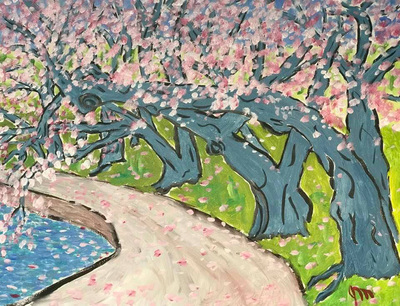Fine Art Prints

Posted on 4/25/2020 6:43:49 PM by John MacArthur
If you have ever had the opportunity to watch a very small child trying to develop motor skills, you know as they get older, they get frustrated. At the earliest point, they are happy just trying to put the pegs in the holes. If one doesn't work, no problem, there is another. As they get older, they are not as patient. The pegs are supposed to go into the holes. It takes a bit to learn which peg will work with each hole.
Once the skill is mastered, it becomes a default life style. We believe that every round peg will have to be in a round hole and every square peg will fit in a square hole. It becomes exponential. Learned patterns are comfortable. We don't have to think. Sadly, it is easy not to be challenged.
Art falls into these sort of patterns as well. Even though art is always evolving, eventually a style is accepted and becomes a norm. It has been that way since the Renaissance. Equipment and lifestyle brought about most of the changes. Charcoal gave way to lead which gave way to ink. Pigment was ground by the artist, then placed in pig's bladders. The creation of the tube changed that and art became more portable.
Two dimension gave way to three dimension. Realism gave way to cubism. Painterly gave way to abstract. It was always art and in always became accepted. These are things learned in Universities or Ateliers. Knowledge becomes power. Knowledge becomes language.
Then there are the Naif artists. Unless you are an artist yourself or have studied art in depth, you probably have not heard of Naif (or Naïve) art, though you may have seen examples without realizing it. One defining quality of Naif art is that it is a form of visual art that is created by someone who has never received formal artistic education and training. The artists are self-taught, giving credence to the belief that artistic ability is an innate gift.
Naif paintings are recognized for their uncomplicated or youthful simplicity. They often apply a flat style to the representation of their subjects with the most basic expression of perspective. At other times, they use atmospheric observation to create depth and/or perspective.
Ancient cave paintings are the first example of this art form. The most well-known are the prehistoric paintings of the Caves of Lascaux in Perigord, France. It makes sense. There were no Universities or Ateliers operating at that time.
The pieces are often full of color like the cherry blossom scene above. While that tree doesn’t really look like a tree, you still know that’s what it’s meant to be, and that’s part of the appeal of this kind of art. Other colorful pieces are the cityscape I have done. You can’t necessarily tell what’s what, and that doesn’t bother you at all!
People are often depicted too, and they are far more elaborate than the stick figures I drew as a kid. I have done a painting of what amounts to a modern day horse race in Sienna, Italy. There are people and horses, but they are simply and beautifully rendered in a colorful fashion.
You can see that Naïf art is generally joyful, like a bright painting of a bridge in Paris, and provides a sense of happiness as well as spontaneity. These pieces of Naif art might not have the dimension of those in other genres, but they are no less beautiful and thought-provoking.